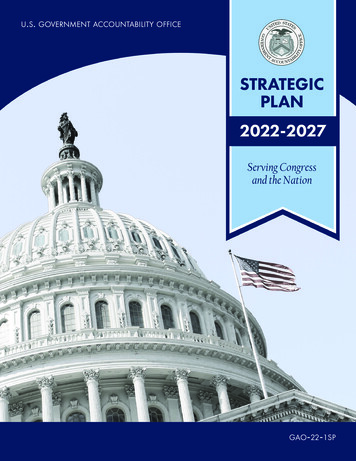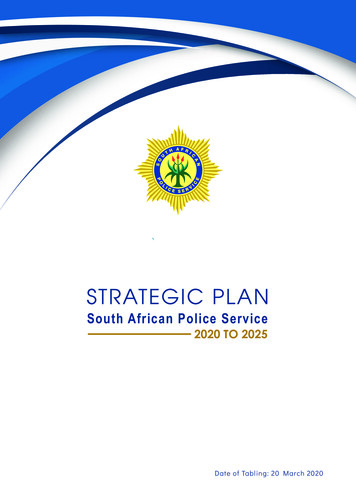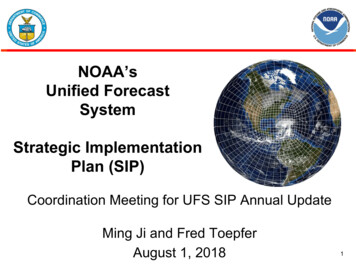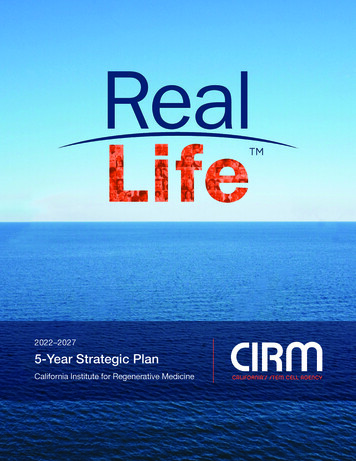
Transcription
GAO STRATEGICu.s. government accountabilityofficePLAN 2022-2027STRATEGICPLAN2022-2027Serving Congressand the Nation1 GAO STRATEGIC PLAN 2022-2027GAO-22-1SPgao-22-1sp
GAO STRATEGIC PLAN 2022-2027STRATEGIC FRAMEWORKMISSIONGAO CORE VALUESGAO exists to support the Congress in meeting itsconstitutional responsibilities and to help improve theperformance and ensure the accountability of the federalgovernment for the benefit of the American people.MISSION VALUESPEOPLE ectedTreated FairlyTRENDS SHAPING THE U.S. AND ITS PLACE IN THE WORLDNationalSecurity:Global andDomestic ThreatsFiscalSustainabilityand DebtPreparing forCatastrophicBiologicalIncidentsRacialand EthnicDisparitiesScience,Technology,and theInnovationEconomySecurityImplicationsfor anIncreasinglyDigital WorldChanges toHow andWhereWe WorkFuture ofGlobalSupplyChainsOnlineLearning andTechnology velopmentEvolvingSpaceEnvironmentGOALS1Well-being andFinancial Security2National Securityand GlobalInterdependenceProvide timely, qualityservice to the Congress andProvide timely, quality servicethe federal government toto the Congress and the federaladdress current and emerginggovernment to respond tochallenges to the well-beingchanging security threats andand financial security of thechallenges of national securitypeople.2 American GAO STRATEGICPLAN 2022-2027and GAO ValueHelp transform the federalgovernment to addressnational challenges.Maximize the value of GAOby enabling quality, timelyservice to the Congressand by being a leadingpractices federal agency.GAO-22-1SP
GAO STRATEGIC PLAN 2022-2027ABOUT THIS PL ANThe Government Performance and Results Act of 1993 (GPRA),as amended, requires most federal agencies to develop strategic plans.GAO, as a legislative branch agency, is exempt from many federalmanagement laws, including GPRA. However, we generally holdourselves to the spirit of these laws. As such, we consider this strategicplan to include information comparable to what isrequired by GPRA.GAO-22-1SPGAO STRATEGIC PLAN 2022-2027 3
GAO STRATEGIC PLAN 2022-2027TABLE OF CONTENTSSTRATEGIC FRAMEWORK. 2ABOUT THIS PLAN. 3ABBREVIATIONS List of Abbreviations. 5LETTER FROM THE COMPTROLLER GENERAL Gene L. Dodaro. 6GAO FACTS AND FIGURES Who we are and what we do. 8GAO ORGANIZATION Our reporting structure. 9GOAL 1 Address Current and Emerging Challenges to the Well-Being and Financial Security of the American People. 111.1 Programs and Financing to Serve the Health Needs of an Aging and Diverse Population1.2 Lifelong Learning to Enhance U.S. Competitiveness1.3 Benefits and Protections for Workers, Families, and Children1.4 Financial Security and Well-Being of an Aging Population1.5 Fair, Responsive, and Effective System of Justice1.6 Housing Finance and Viable Communities1.7 A Stable Financial System and Sufficient Consumer Protection1.8 Responsible and Sustainable Stewardship of Natural Resources and the Environment1.9 A Viable, Safe, Secure, and Accessible National Physical Infrastructure1.10 Efforts to Fulfill the Federal Government’s Responsibilities to Tribes, Their Members,and Individual DescendantsGOAL 2 Help the Congress Respond to Changing Security Threats and the Challenges of Global Interdependence.222.1 Protect and Secure the Homeland from Threats and Disasters2.2 Effectively and Efficiently Utilize Resources for Military Capabilities and Readiness2.3 Advance and Protect U.S. Foreign Policy and International Economic Interests2.4 Improve the Intelligence Community’s Management and Integration to Enhance Intelligence Activities2.5 Ensure the Cybersecurity of the NationGOAL 3 Help Transform the Federal Government to Address National Challenges.283.1 Analyze the Government’s Fiscal Condition and Opportunities to Strengthen Managementof Federal Finances 3.2 Support Government Accountability by Identifying Fraud, Waste, and Abuse, and NeededImprovements in Internal Controls3.3 Support Congressional Oversight of Crosscutting Issues, Major Management Challenges, andProgram Risks3.4 Support Congressional Knowledge, Understanding, and Oversight of Science and Technology IssuesGOAL 4 Maximize the Value of the GAO by Enabling Quality, Timely Service to the Congress and by Being a LeadingPractice Federal Agency.33 4.1 Empower GAO’s Diverse Workforce to Continue to Excel in Mission Delivery through Strategic TalentManagement 4.2 Refine GAO’s Processes to Deliver High Quality Results and Products, and Promote Knowledge Sharing,Government Standards, and Strategic Solutions4.3 Provide Modern Integrated Tools and Systems in a Secure, Collaborative, and Flexible EnvironmentGAO TEAMS Guide to GAO Teams.37ADDITIONAL INFORMATION Image Sources, Obtaining Copies of GAO Reports.39COMMUNICATING WITH GAO GAO Contact Information.434 GAO STRATEGIC PLAN 2022-2027GAO-22-1SP
GAO STRATEGIC PLAN 2022-2027ABBREVIATIONSAIartificial intelligenceCBOCongressional Budget OfficeCOVID-19Coronavirus Disease 2019DODDepartment of DefenseDOEDepartment of EnergyHUDDepartment of Housing and Urban DevelopmentICIntelligence CommunityIIJAInfrastructure Investment and Jobs ActISISIslamic State of Iraq and SyriaNNSANational Nuclear Security AdministrationODNIOffice of the Director of National IntelligenceS&Tscience and technologyTreasuryDepartment of the TreasuryUSPSU.S. Postal ServiceVADepartment of Veterans AffairsGAO-22-1SPGAO STRATEGIC PLAN 2022-2027 5
GAO STRATEGIC PLAN 2022-2027LETTER FROM THE COMPTROLLER GENERALMarch 2022I am pleased to present GAO’s Strategic Plan for Servingthe Congress and the Nation for fiscal years 2022 to2027. As the nation works to recover from the effects of theCOVID-19 pandemic, new and long-standing challengesface the federal government. This plan describes our goalsand strategies in this evolving environment to supportthe Congress. It is designed to identify cost savings andother financial opportunities; to make government moreaccountable, efficient, and effective; and ultimately toimprove the safety, security, and well-being of the Americanpeople.GAO’s efforts during this planning period will include workthat identifies cost savings, revenue enhancements, and otheropportunities through legislative action and GAO’srecommendations for improved government operations; monitors and assesses federal efforts to respond to acomplex national security environment and protect thenation and its critical infrastructure from cyberattacks andother threats; evaluates the preparedness of the nation for future risks,including public health emergencies, extreme weather,and natural disasters; draws needed attention to long-term fiscal exposuresand large and growing areas of federal spending, suchas health care and interest costs; helps the Congress anticipate and respond to a rangeof emerging issues, including advances in scienceand technology that will transform activities acrossgovernment and society; and recommends enhancements to achieve effective, efficientand equitable outcomes of government programs andpolicies.At the beginning of this planning period, GAO continuesto oversee and evaluate the over 4 trillion in spending inresponse to COVID-19—the largest rescue package in U.S.6 GAO STRATEGIC PLAN 2022-2027history. The pandemic has resulted in substantial loss of lifeand significant economic repercussions. Until public healthgoals can be achieved, the pandemic will likely remain anobstacle to stable and robust economic activity. After suchgoals are attained and the economy substantially recovers,swift and focused attention will be needed to develop anapproach to place the government on a sustainable longterm fiscal path.Our work and our recommendations for action will placeemphasis on saving the government money throughimproved operations and by highlighting the large-scalefiscal exposures and financial liabilities that can threaten thesustainability of the federal government’s finances over time.We will further support congressional oversight across awide array of government programs and operations. This isdone in part through our High Risk work and other effortsto identify areas that could reduce fragmentation, overlap,and duplication. GAO’s High Risk List provides a road mapfor priority actions needed in agencies and program areasthat we deem high risk due to their vulnerabilities to fraud,waste, abuse, and mismanagement, or are most in need oftransformation.Areas on the High Risk List cover some of the largest andmost complex agencies and programs. This includes theDepartment of Health and Human Services’ leadership andcoordination of public health emergencies, Departmentof Defense weapons systems and business operations,Medicare, Medicaid, Department of Veterans Affairs healthcare, and the Internal Revenue Service enforcement of taxlaws.The list also highlights areas where the government faceslarge and potentially unknown future financial liabilities,such as hundreds of billions of dollars in flood insuranceclaims. Moreover, the High Risk List includes a numberof areas focused on the health, safety, and well-being ofAmericans, including efforts to prevent and respond to drugmisuse, the control of toxic substances, food safety, oversightof medical products, and protecting the nation’s criticalGAO-22-1SP
GAO STRATEGIC PLAN 2022-2027LETTER FROM THE COMPTROLLER GENERALinfrastructure from cyberattacks.With the issuance of this strategic plan, the U.S. GovernmentAccountability Office embarks on its second century ofwork supporting the Congress by helping to improve theperformance and ensure the accountability of the federalgovernment for the benefit of the American people. Sinceour founding, we have evolved into an agency of dedicatedand multidisciplinary staff, made up of experts in conductingfinancial and performance audits, program evaluations,policy analysis, and technology assessments coveringvirtually every federal program, activity, and function.Looking ahead, GAO continues to perform foresight workto help the Congress further understand the implicationsof emerging issues that pose both risks and opportunitiesfor the federal government. GAO’s Center for StrategicForesight will help highlight these emerging issues with oursubject matter experts, covering areas such as scienceand technology, innovation in financial services, nationalsecurity, cybersecurity, and infrastructure.In the trends that accompany the goals and objectives ofthis plan, we outline a number of drivers that will affect theevolution of federal programs and activities that GAO willevaluate as we support the Congress in the coming years.Some of these are long-standing issues, while others haveemerged more recently with the potential to rapidly affectgovernment and society.Board and other GAO advisory bodies, which includerepresentatives from the federal inspectors general, stateand local government audit communities, academia,and other experts; and other organizations, includingthe Congressional Budget Office and the CongressionalResearch Service. We have reviewed and incorporatedthese and other comments into the final version of the plan,as appropriate.If you have any questions, please contact me at(202) 512-5500 or dodarog@gao.gov or ManagingDirector for Strategic Planning and External Liaison,Stephen Sanford, at (202) 512-4707 or sanfords@gao.gov.Sincerely,Gene L. DodaroComptroller General of the United StatesAbove all else, we will safeguard the high quality of ournon-partisan, professional, and objective work. We will dothis by working effectively and efficiently while at the sametime demonstrating agility to adapt to changing trends andexternal factors and maintaining our strong commitment to askilled and diverse workforce.To ensure this plan accurately reflects the needs of theCongress and the nation as a whole, this plan incorporatesour continual outreach to our congressional clients. Wefurther invited comments on a draft of this plan fromMembers of Congress and their staff of our key oversightand client committees; the Comptroller General’s AdvisoryGAO-22-1SPGAO STRATEGIC PLAN 2022-2027 7
GAO STRATEGIC PLAN 2022-2027GAO FACTS AND FIGURESABOUT USACCOMPLISHMENTSin fiscal year 2021GAO is an independent, nonpartisan professional servicesagency in the legislative branch of the federal government.Commonly known as the audit and investigative arm of theCongress or the “congressional watchdog,” we examine how 66.2 billion infinancial benefits1,602 newrecommendations 158 five-year averagereturn on each 1Congress invests in us1,239 improvementsin federal governmentoperationstaxpayer dollars are spent and advise lawmakers and agencyheads on ways to make government work better. GAO wasestablished under the Budget and Accounting Act of 1921 toinvestigate how federal dollars were spent. The ComptrollerGeneral of the United States is the head of GAO.Gene L. Dodaro is the current Comptroller General.MISSION VALUESREPORTS578 reports67 congressionaltestimoniesAbout 2,000bid protestshandledOver 500 legaldecisions andopinions issued AccountabilityEnhance the economy, efficiency, effectiveness, andcredibility of the federal government. IntegrityConduct professional, objective, fact-based, nonpartisan,non-ideological, fair, and balanced work. ReliabilityProduce timely, accurate, constructive, clear, andcandid products.PEOPLE VALUESOUR EMPLOYEESGAO is composed of over 3,300employees possessing academicdegrees in various fields, including: Budget Accounting SocialScience Security Law Human Engineering PhysicalScienceCapital Information Subject-Area Contract andTechnologySpecialistsAcquisition EconomicsOUR LOCATIONSSource: GAO. GAO-22-1SPWashington, D.C. leLos AngelesNorfolkOaklandSeattle
GAO STRATEGIC PLAN 2022-2027GAOORGANIZATIONGAO’sOrganization ChartStaff OfficesCongressionalRelationsPublic AffairsA. NicoleClowersChuck YoungStrategic Planningand External LiaisonMaryMohiyuddinGene DodaroOpportunity andInclusivenessStephenSanfordActing InspectorGeneralComptroller General of theUnited StatesKate LenaneGeneral CounselChief Administrative Officer/Chief Financial OfficerChief Operating OfficerEddaEmmanuelli-PerezOrice Williams BrownDeputy GeneralCounsel/ EthicsCounselorChief Quality OfficerKarl MaschinoContinuous ProcessImprovementTimothy BowlingJulie MattaKaren BrindleAudit PolicyQuality AssuranceManaging AssociateG.C. Legal OperationsDeputy ChiefAdministrative OfficerHelen DesaulniersPaul JohnsonFinancial Managementand BusinessOperationsField OperationsTeresa RiveraRussellWilliam AndersonBenjamin NelsonManaging AssociateG.C. Goal 1Managing AssociateG.C. Goal 1Susan SawtelleRenee CaputoInformation Systemsand onalDevelopment ProgramHuman CapitalLisa MotleyManaging AssociateG.C. Goal 2Managing AssociateG.C. Legal ServicesJoan HollenbachTerrell DornManaging AssociateG.C. Goal 3Managing AssociateG.C. Goal 3Learning CenterManaging AssociateG.C. Procurement LawManaging AssociateG.C. Procurement LawMary MoutsosRobert CramerJennifer GroverKirstin AustinShirley JonesRalph WhiteHoward WilliamsKenneth PattonMission TeamsApplied Researchand MethodsLawranceEvans JrContracting andNational SecurityAcquisitionsMichele MackinDefenseCapabilities andManagementCathleen BerrickEducation, Workforce,and Income SecurityCindy BrownBarnesFinancialManagement andAssuranceLarry MalenichFinancial Marketsand CommunityInvestmentDaniel Garcia-DiazTechnical ChiefsChief AccountantRobert (Bob)DaceyForensic Auditsand InvestigativeServiceJohana AyersHealth CareJessica FarbHomeland Securityand JusticeCharlesJohnsonInternationalAffairs and TradeThomas MelitoInformationTechnology andCybersecurityNick MarinosNatural Resourcesand EnvironmentPhysicalInfrastructureStrategic IssuesMichelle SagerDavid TrimbleScience, Technology Assessment, and AnalyticsTimothyPersons, PhDMark GaffiganJohnNeumannChief ScientistTechnical ChiefChief ActuaryFrank TodiscoChief Data Scientistand Director of theInnovation LabChief EconomistvacantTaka ArigaLegend:The Executive CommitteeNote: Everyone listed on this table, other than the Comptroller General, is a Senior Executive Service (SES) level manager. Also, with the exception of the Comptroller Generalof the United States, the Chief Operating Officer, the Chief Administrative Officer, the Deputy Chief Administrative Officer, the Inspector General, the General Counsel, theDeputy General Counsel, the Chief Quality Officer, the Chief Information Officer, the Chief Human Capital Officer, the Chief Learning Officer, and the Technical Chiefs, the SESmanagers are titled “Managing Director.”GAO-22-1SPDecember 2021GAO STRATEGIC PLAN 2022-2027 9
GAO STRATEGIC PLAN 2022-2027STATDETEISNUACLIENTYO F FIC EGOVERNMTC O U N TA10 GAO STRATEGIC PLAN 2022-2027IBGAO-22-1SP
STRATEGIC OBJECTIVES1.1 Programs and Financingto Serve the Health Needsof an Aging and DiversePopulation1.2 Lifelong Learning to EnhanceU.S. CompetitivenessGOAL 1Address Current andEmerging Challenges to theWell-Being and FinancialSecurity of theAmerican People1.3 Benefits and Protectionsfor Workers, Families, andChildren1.4 Financial Security and WellBeing of an Aging Population1.5 Fair, Responsive, and EffectiveSystem of Justice1.6 Housing Finance and ViableCommunities1.7 A Stable Financial Systemand Sufficient ConsumerProtection1.8 Responsible and SustainableStewardship of NaturalResources and theEnvironment1.9 A Viable, Safe, Secure, andAccessible National PhysicalInfrastructure1.10 Efforts to Fulfill the FederalGovernment’s Responsibilitiesto Tribes, Their Members, andIndividual Descendants
GAO STRATEGIC PLAN 2022-2027STRATEGIC OBJECTIVE 1.1Programs and Financing to Serve the Health Needsof an Aging and Diverse PopulationTotal health care spending in the United States continuesto grow faster than the economy. CBO projects federalspending on major health care programs net of offsettingreceipts to grow from 1.3 trillion in fiscal year 2021 to 2.3trillion in fiscal year 2031. The growth will be driven, in part,by the aging of the population and increasing health carespending per person. The ongoing effects of the COVID-19pandemic—including increases in mental health conditionsand the ongoing need for vaccines and therapeutics—arelikely to result in additional health care spending growth.For example, the COVID-19 pandemic increased the use oftechnological innovations, like telemedicine and autonomousrobots in hospitals, but such health advances generallyincrease total spending.members) is becoming more challenging. The seriousrepercussions of the pandemic underscore the importanceof preparing for, detecting, responding to, and recoveringfrom catastrophic biological incidents. These events candisrupt health care delivery and worsen longer-term publichealth concerns, such as drug misuse and mental healthconditions. For example, some of the populations most atrisk of severe COVID-19 illness are also populations thatare disadvantaged in their access to health care, includingindividuals from specific racial or ethnic groups and thosewho are socioeconomically disadvantaged. Disparities inhealth outcomes and the provision of health care for theseand other potentially vulnerable populations will continue tobe a focus of federal health care programs.The demands to meet Americans’ health needs aregrowing in volume and complexity, while effectivelyand efficiently managing health care programs (such asMedicare, Medicaid, and programs for veterans, militaryservicemembers and their families, and tribes and theirGAO’s work will continue to help the Congress by examiningand addressing public and private health care coverage,health care financing and program integrity, healthdisparities, and the management of public health.PERFORMANCE GOALS1.1.1: Assess trends, costs, and issues in privatehealth insurance coverage1.1.2: Assess efforts to reduce improper paymentsand fraud, waste, and abuse in federal healthcare programs1.1.3: Evaluate Medicare reform, financing,expenditures, and operations1.1.4: Evaluate Medicaid financing, expenditures,and oversight12 GAO STRATEGIC PLAN 2022-20271.1.5: Assess efforts to provide health care forpotentially vulnerable populations, includingprograms serving tribes and their members1.1.6: Assess actions and options for improvingVA’s and DOD’s health care services1.1.7: Evaluate the effectiveness of federalprograms to promote and ensure public health,including the safety and efficacy of drugs andmedical devices and preparing for, responding to,and recovering from public health emergenciesGAO-22-1SP
GAO STRATEGIC PLAN 2022-2027STRATEGIC OBJECTIVE 1.2Lifelong Learning to Enhance U.S. CompetitivenessAccess to high quality lifelong learning opportunities iscentral to enhancing U.S. competitiveness in the globaleconomy. Potential workers’ access to these opportunitiesis impeded by inequities in primary and secondaryeducation, college tuition costs, and greater needs amongnontraditional students for coordinated support, such aschild care. The COVID-19 pandemic created additionalchallenges, exposed existing inequities that impedeaccess to instruction and work, and highlighted changes inemployment relationships and work attitudes. As technology transforms the workplace, most Americanjobs will require at least some higher education. At thesame time, rising tuition costs have propelled federalstudent loan debt to almost 1.6 trillion and have impededaccess to higher education for many. Many students, particularly those from underservedcommunities who lack equitable opportunities forsafe, high-quality learning, graduate from high schoolunprepared for the workplace or college.GAO’s work will help the Congress assess these trends andchallenges to ensure U.S. competitiveness. Federal education and workforce training programsmust work together to build a knowledgeable and skilledworkforce while adjusting to the evolving economy, workenvironment, and local needs.PERFORMANCE GOALS1.2.1: Assess policy and administrative challenges to improving school readiness and equitableaccess to a safe, high-quality K-12 education1.2.2: Identify opportunities to improve efficiency, effectiveness, equity, access, andaccountability in higher education, including programs that provide federal student aid1.2.3: Identify improvements to advance the efficiency, effectiveness, equity, and results ofprograms that facilitate job opportunities and enhance skills for workers, including youth andveterans, for in-demand occupations in an evolving economyGAO-22-1SPGAO STRATEGIC PLAN 2022-2027 13
GAO STRATEGIC PLAN 2022-2027STRATEGIC OBJECTIVE 1.3Benefits and Protections for Workers, Families, and ChildrenThe federal government and states jointly administera range of programs that promote employmentopportunities and safe workplaces, help people whocannot work, and support and protect low-income andvulnerable populations, including children. The nation’ssafety net programs have been profoundly affectedby the COVID-19 pandemic as well as by longer-termshifts in the U.S. economy. Following the pandemic, anincreased number of households sought public assistanceand challenged federally supported programs’ abilityto provide efficient services while ensuring programintegrity. For example, federal outlays for unemploymentcompensation increased from 117 billion in fiscal year2011 to 472 billion in 2020 and an estimated 539 billion in 2021. The estimated 2021 outlays for foodassistance also rose sharply in recent years to 202 billion.GAO’s work will help the Congress address challenges toensure that those with needs can access efficient, effective,and coordinated programs while also protecting programintegrity.PERFORMANCE GOALS1.3.1: Identify opportunities to improve programs that provide social services and economic andnutrition assistance to individuals, families, and children1.3.2: Assess the effectiveness of strategies and safeguards to protect workers, both domesticallyand internationally1.3.3: Identify ways to improve federal policies and support for individuals, including veteransand others with disabilities14 GAO STRATEGIC PLAN 2022-2027GAO-22-1SP
GAO STRATEGIC PLAN 2022-2027STRATEGIC OBJECTIVE 1.4Financial Security and Well-Being of an Aging PopulationEnsuring that older adults have a financially secureretirement is a shared goal of government, employers,and individuals. However, several factors pose challengesto achieving this goal. Social Security continues to faceserious long-term financial challenges—with the assets inits Old-Age and Survivors Insurance Trust Fund expectedto be depleted by 2033—largely because people areliving longer and there are fewer working adults to supportbenefits for a growing number of retirees.In addition to Social Security, employer-sponsoredretirement plans provide a vital source of income forolder adults. However, employers have shifted moreresponsibility and risk to individuals for ensuring theirown retirement security and many workers lack equitableaccess to such plans. As a result, many individuals willhave to work longer, save more, and learn to managethose savings. Meanwhile, despite the growing needfor community-based services to help seniors remainindependent, fiscal pressures at all levels of governmentmay limit funding for such services.To address these challenges, GAO will conduct analysesthat will help the Congress and policymakers assist millionsof Americans in attaining and maintaining a secureretirement.PERFORMANCE GOALS1.4.1: Assess the policy and administrative challenges to financing government benefits for olderadults1.4.2: Assess policies and programs that help individuals achieve financial security and maintaintheir independence in retirement1.4.3: Assess the adequacy and effectiveness of private and public employer-sponsoredretirement plans in providing older adults an equitable and financially secure retirementGAO-22-1SPGAO STRATEGIC PLAN 2022-2027 15
GAO STRATEGIC PLAN 2022-2027STRATEGIC OBJECTIVE 1.5Fair, Responsive, and Effective System of JusticeThe American people face a wide range of criminalthreats that require a responsive, fair, and effectivesystem of justice. Events across the United States havesparked discussions about the role of federal and locallaw enforcement, particularly their use of lethal force,but also their capabilities in identifying and addressingsources of criminal threats, and in processing individualsfairly, effectively, and justly throughout the justice system.In addition, debates continue on how best to ensure fair,equitable, and reliable elections.Communities across the United States continue toexperience violent crimes, including gun violence andmass shootings that result in casualties at schools, events,and other locations. The growing amount of illicit drugtrafficking activity also has led to an increasing number ofoverdose deaths. Further, the ever-evolving opportunitiesfor online criminals to use digital platforms to exploitvulnerable populations has helped enable the traffickingof humans in communities across the United States. Lawenforcement’s ability to address these issues, such as byidentifying and countering illicit activity online, will dependon its ability to understand and employ new technologieswhile also ensuring the rights of citizens.Regarding those brought to justice, debate also continueson how best to ensure the nation’s criminal and civilpenalties, as well as sentencing guidelines, help formthe foundation for a fair and equitable judicial system.Effectively managing the federal offender populationremains critical, especially ensuring that rehabilitativeprograms help facilitate better outcomes that discouragereturning to crime for adults and juveniles re-enteringsociety.To address, mitigate, and manage these significant andvast threats, U.S. law enforcement and justice systemsneed to continuously adapt to changing approachesused by criminal organizations and others. For example,it will be essential for the federal government to disruptillicit drug trafficking and enhance criminal justice effortsto address drug misuse. In addition, state and localgovernments and other sectors of society have key roles inaddressing these threats. It will be important for the federalgovernment to ensure that training, technical assis
GAO-22-1SP GAO STRATEGIC PLAN 2022-2027 3 GAO STRATEGIC PLAN 2022-2027 ABOUT THIS PLAN The Government Performance and Results Act of 1993 (GPRA), as amended, requires most federal agencies to develop strategic plans. GAO, as a legislative branch agency, is exempt from many federal management laws, including GPRA. However, we generally hold










